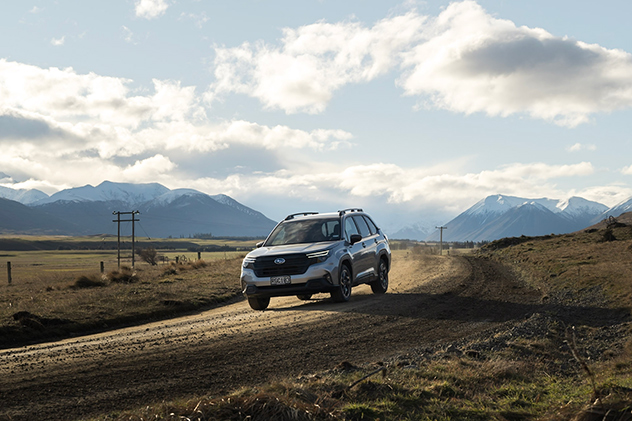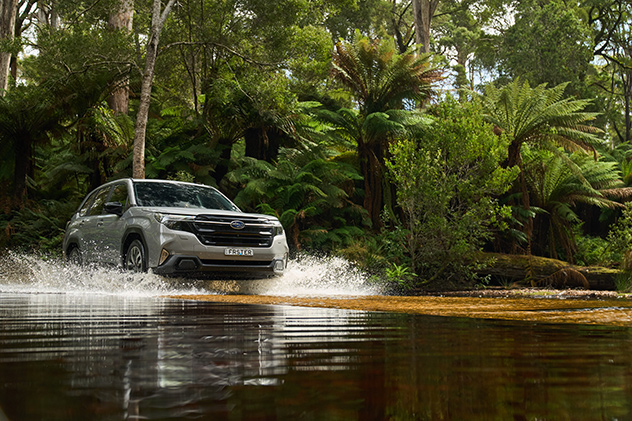
Subaru tried its hand at a hybrid engine for the last generation of its Forester SUV, but didn’t exactly win awards for the attempt due to what many considered an underperforming system.
Not content with this, the Japanese brand has tried again at creating a bona fide ‘strong’ hybrid system (now borrowing technology from development partner Toyota), and has released it in the all-new, sixth-generation Forester.
We headed over to New Zealand and put the Forester’s new hybrid system – as well as a raft of other updates the new generation has received – to the test.
A total of seven variants comprise the 2025 Subaru Forester range, with four powered solely by petrol and three receiving the hybrid system. An updated naming convention also makes its debut.
Prices have hiked between $2400 and $5850 compared to the previous generation, making the Forester’s cost of entry higher than the hybrid Toyota RAV4 ($42,260).
Entry level ‘Forester’ grade, powered by a petrol engine, kicks off the range from $43,490 before on-road costs. The Premium, Sport and Touring models, also petrol-powered, come in at $46,490, $48,490 and $50,990 respectively.
The hybrid line-up starts with Forester Hybrid at $46,490, jumping a grade to Hybrid Sport for $54,990, and concluding with flagship Hybrid Touring for $55,990.
Keen-eyed readers might notice these represent an inconsistent additional cost of between $3000 and $6500 for the hybrid system depending on grade. This is due to further kit added on some hybrid variants – more on that later.
The 2025 Subaru Forester is covered by a five-year, unlimited-kilometre warranty, with hybrid variants receiving an eight-year/160,000km assurance on their lithium-ion batteries.
Servicing costs vary from $348 to $679 per visit, with 15,000km/12-month intervals.










Taking rugged adventure and making it feel civilised has always been the Forester’s focus over all-out luxury, and the formula remains unchanged inside the 2025 Subaru Forester.
Soft-touch claddings are used sparingly but to good effect, coming together with hard surfaces to create a cabin that’s comfortable without feeling fragile.
Thin pillars, a sunken doorline and a generous rear window aperture all combine to provide great visibility, creating a sense that the Forester is taller than it really is – a helpful attribute both on- and off-road. An electric sunroof which comes standard on Sport and Touring (regardless of powertrain) also adds to an airy feel inside.
Dense cloth upholstery, available in black or a grey and platinum combo, features inside base and Premium grades, uprated to a water repellent grey and black material for Sport variants. The flagship Touring scores black leather and suede with the option of brown accenting. Steering wheels are wrapped in what feels like high-quality leather on all variants, with stitching colour denoting grade level.
A vertically orientated 11.6-inch centre touchscreen is fitted as standard in this new generation, running Android Auto, Apple CarPlay, DAB radio and sat nav with dedicated sections for climate control and real-time driving information. The screen is responsive and one of the more smudge-resistant ones we’ve encountered.
The 4.2-inch driver display screen, fitted to all petrol variants and base hybrid, is replaced by a full-size 12.3-inch digital cluster for Hybrid Sport and Hybrid Touring, showing additional information including maps and functions of Subaru’s EyeSight safety suite.
Front seat heating comes standard on all grades, with eight-way electric adjustability added on Premium and up in petrol, and Sport and up in hybrid. Ventilation is added to Touring trim. Notably, no grade scores steering wheel or rear seat heating – something uncomfortably emphasised during our testing as the temperature nudged 0ºC – and feels at odds with the Forester’s adventure-ready reputation.
While on the subject, ground clearance (of which the Forester has 220mm) and boot space have taken packaging precedent over placement of the hybrid system’s battery pack in the rear floor. The result? All hybrid variants miss out on a spare (even a space saver), instead receiving a puncture repair kit. Thankfully, petrol versions still come fitted with a full-size spare, but something about a flagship Forester coming with a repair kit doesn’t seem right.
Standard equipment has grown for the 2025 Subaru Forester.
That 11.6-inch centre screen is joined by wireless phone charging, USB-A and -C ports, and a 360-degree camera system on all variants.
A standard six-speaker sound system comes fitted on entry-level hybrid and all petrol variants up to and including Sport, with petrol Touring, Hybrid Sport and Hybrid Touring all sporting a 10-speaker Harmon Kardon system (one of the multiple but subtle spec variations justifying the cost difference between hybrid versions mentioned earlier).
All petrol and base hybrid variants ride on 18-inch alloys, with 19-inch pieces fitted to Hybrid Sport and Hybrid Touring. Different colours and machine finishes further denote specification, with Hybrid Sport receiving bronze units with a very STI (Subaru’s motorsport division) vibe.
The 2025 Subaru Forester scores five stars from ANCAP thanks to a seriously long list of standard safety features.
Some inclusions are speed and traffic sign recognition, adaptive cruise control, driver monitoring, lane change and keeping assistance, automatic reverse braking, rear cross-traffic monitoring, and lane departure warnings.
A wider-angle camera (with larger field of view) has been added, giving Subaru’s EyeSight driver assistance system more scope to identify hazards.
New as well for 2025 is an ‘Emergency Driving Stop System’, able to bring the car to a gradual stop after detecting a driver has been unresponsive for an extended period.
Both a pure petrol and flagship ‘strong’ petrol-hybrid powertrain are available in the 2025 Subaru Forester.
The former consists of a 2.5-litre flat four-cylinder ‘boxer’ engine, sending 136kW and 247Nm to a continuously variable transmission. Subaru claims the pure petrol Forester will drink 7.9L/100km on a combined cycle.
Hybrid models are also powered by a 2.5-litre flat four-cylinder ‘boxer’ engine, except it’s been modified to run on a more efficient but less powerful Atkinson cycle, producing 121kW and 212Nm by its lonesome. The addition of a 1.1kWh battery pack and electric motor (able to output 90kW and 276Nm) increases system outputs to 145kW, though an official torque figure remains undisclosed.

Fuel consumption for the hybrid is claimed at 6.2L/100km, representing a reduction of almost a quarter over petrol-only variants.
Both powerplants are bolted to Subaru’s famed symmetrical all-wheel-drive system, with the hybrid able to achieve permanent AWD and even torque-split mechanically due to its electric motor being placed pre-transmission (versus being independently mounted on the rear axle like what’s seen on the Toyota RAV4 AWD).
Braked towing is rated at 1800kg for petrol-only variants, dropping to 1200kg for hybrid models.
It may be an all-new generation, but the 2025 Subaru Forester’s DNA remains unchanged from previous iterations. It’s a solid performer.
Ride composure proved excellent across varied road conditions and surfaces (both on- and off-road) during our tour across New Zealand. Improvements to chassis rigidity and steering tuning help provide a calm ride over imperfections that would unsettle many cars.
The 2025 Subaru Forester is not rapid when it comes to mid-turn rotation, but the chassis reacts well to inputs, providing good feedback and directness, all while offering stability and swallowing bumps. The transition towards the limit of tyre grip happens smoothly and linearly, providing great confidence. Subaru had to draw the line between performance and comfort somewhere, and we think it got the balance millimetre perfect.










— Liam Murphy
Cabin ambience is refined, even if the new Forester has fewer aspirations to luxury than some of its rivals. Improved sound deadening (and thicker front glass), seat fastening directly to the chassis, as well as revised seat bolster design, keep drivers and passengers comfortable even over long tours over less-than-perfect roads, with very little head wobble or drone in the cabin.
Both powertrains are uninspiring but adequate. Tweaked gear ratios for the pure petrol have seen it pick up both low-speed haste and top-end efficiency, but it’s still a hard slog getting up to highway speeds, with the flat four often shooting a good chunk of the way towards its ~6000rpm redline when asked for even moderate acceleration. Thankfully, this is less noticeable with the additional sound insulation.
The hybrid delivers better performance in about every measurable way. We saw fuel consumption of 7.2L/100km from the hybrid (compared to 8.3L/100km in the pure petrol), although much of our touring was done at 100km/h and it’s likely this efficiency gap would widen in a more urban setting.
The hybrid feels more torquey, though it’s nowhere near as punchy as you might expect given the on-paper figures of the petrol engine and electric motor. With only 9kW more peak power gained from the hybrid system – but offset against the system’s additional ~100kg of heft – the power-to-weight ratio remains largely unchanged over the pure petrol. It is the better package, but the improvement in on-road acceleration is negligible considering it’s the flagship powertrain.
In our opinion, brake regeneration (whereby the hybrid system’s electric motor uses vehicle momentum during deceleration to recharge the battery), has been tuned too aggressively, leading to a sensitive brake pedal that ‘drags’ quite a bit compared to its petrol counterpart.
Following an off-road component of our testing, which included a water crossing, the engine of a Forester we were seated in (and one more among the 20-odd media tour fleet) stalled and could not be restarted by us. Subaru Australia attributes this to the vehicles being driven incorrectly during the water crossing, leading to the activation of an inbuilt failsafe.

The Subaru Forester is a household name, and its evolution has long been a process of incremental but tangible improvement. Its sixth generation is, for the most part, a continuation of this trend.
Stability and confidence-inspiring ride and handling continue to play into its reputation as a budget weekend warrior’s dream, but the removal of a full-size spare in its flagship and increased purchase costs do hurt this proposition somewhat.
Pros
Cons